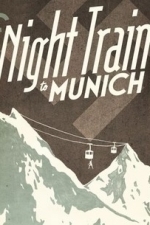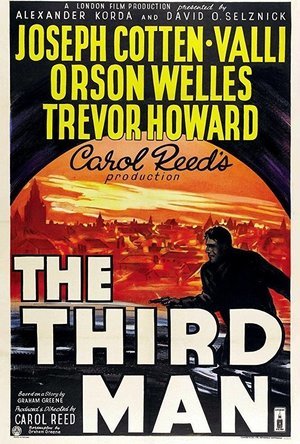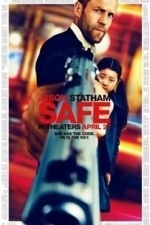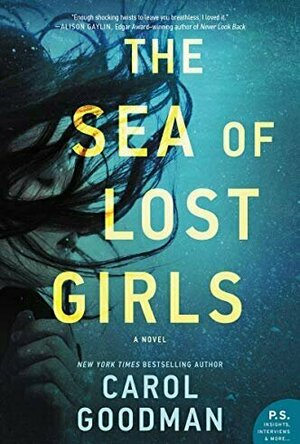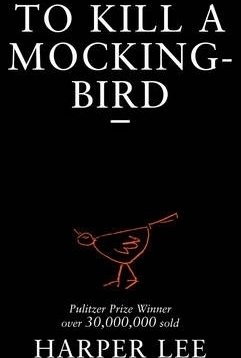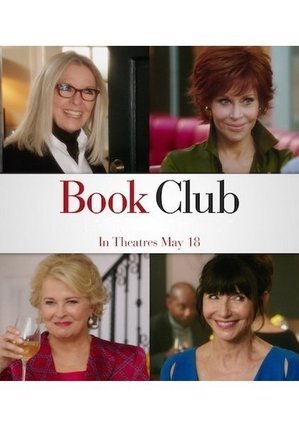Search
Search results
John Malkovich recommended Night Train to Munich (Gestapo) (1940) in Movies (curated)
Alton Brown recommended The Third Man (1949) in Movies (curated)
Gary Giddins recommended The Third Man (1949) in Movies (curated)
Jennifer Reeder recommended Safe (2012) in Movies (curated)
Kristy H (1252 KP) rated The Sea of Lost Girls in Books
Mar 19, 2020
Tessa has started her life over at Haywood, an elite boarding school in coastal Maine. She teaches English there and is married to a well-respected fellow professor, Harmon. Her seventeen-year-old son, Rudy, while troubled in the past, seems to be doing well. This is much in part to his girlfriend, Lila Zeller, a smart and focused teen. But then Tessa gets an early morning text from Rudy, asking her to pick him up. He and Lila had a fight, and Tessa finds him wet and shivering. Later that morning they receive the devastating news that Lila's dead body was found on the beach, not far from where Tessa picked Rudy up. Soon there are whispers of murder surrounding Lila's death, and both Tessa's husband and son find themselves under investigation. And the more she delves into Haywood's past, the more she realizes she isn't the only one keeping secrets.
"When we landed here in this pretty harbor town with its sailboats and white clapboard houses I'd thought we'd come to a place where we'd always be safe. But Rudy has always had a nose for darkness."
I love Carol Goodman's books, and I'm always into a good boarding school book, so picking up this one was a no-brainer. She doesn't disappoint. This is a quick, captivating story that keeps you guessing the entire time. While Tessa isn't always the most likeable character, I was certainly invested in her story.
Goodman deftly weaves two storylines together--the present, featuring Tessa's family and Lila's death and the past, which revolves around the titular lost girls, whom tie back to Haywood in its earlier days. We also learn more about Tessa's past and her long-hidden secrets, many of which also link into Haywood itself. Somehow all of this works together. It's a mysterious, sometimes dark story, and one that keeps you wondering. I changed my mind several times about who could have harmed Lila. I love a book that keeps me on my toes. I also enjoyed the story of the lost girls and the school's eerie stories.
Goodman is a master storyteller, and this book flies by. She brings in links such as "The Crucible," which the Haywood students are performing, and ties to the #metoo movement. They all augment this strong story about the power of lies and hidden secrets. The parallels between the past and present are expertly woven together. 4 stars.
"When we landed here in this pretty harbor town with its sailboats and white clapboard houses I'd thought we'd come to a place where we'd always be safe. But Rudy has always had a nose for darkness."
I love Carol Goodman's books, and I'm always into a good boarding school book, so picking up this one was a no-brainer. She doesn't disappoint. This is a quick, captivating story that keeps you guessing the entire time. While Tessa isn't always the most likeable character, I was certainly invested in her story.
Goodman deftly weaves two storylines together--the present, featuring Tessa's family and Lila's death and the past, which revolves around the titular lost girls, whom tie back to Haywood in its earlier days. We also learn more about Tessa's past and her long-hidden secrets, many of which also link into Haywood itself. Somehow all of this works together. It's a mysterious, sometimes dark story, and one that keeps you wondering. I changed my mind several times about who could have harmed Lila. I love a book that keeps me on my toes. I also enjoyed the story of the lost girls and the school's eerie stories.
Goodman is a master storyteller, and this book flies by. She brings in links such as "The Crucible," which the Haywood students are performing, and ties to the #metoo movement. They all augment this strong story about the power of lies and hidden secrets. The parallels between the past and present are expertly woven together. 4 stars.
Kayleigh (12 KP) rated To Kill a Mockingbird in Books
Jan 2, 2019
Well, February is definitely the month for discovering classics I’ve missed! For some reason, I’d always classed To Kill a Mockingbird in amongst the Agatha Christie genre of murder mysteries – not that I’ve read those either – and didn’t know enough about it for it to have piqued my interest. Now I’ve read it though, I can see what all the fuss is about, and it’s not surprising that, despite being published in 1960, it was still the <a href="http://www.guardian.co.uk/news/datablog/2012/aug/09/best-selling-books-all-time-fifty-shades-grey-compare">65th best-selling book of all time</a> in 2012. Beware of spoilers!
The story is set in Maycomb, Alabama in the 1930s, and is written from the perspective of Jean Louise ‘Scout’ Finch, who is between six and eight years old as the story progresses. The start of the book does an effective job of introducing us to all the characters. Scout lives with her widowed father, Atticus, a lawyer, her brother Jem (who is 4 years older than her) and Calpurnia, a black woman who acts as a type of mother figure. A friend, Dill, also joins them in the summer. The three children are intrigued by Arthur ‘Boo’ Radley, who lives in the house on the corner but is never seen outside. I really enjoyed this part of the story; it set the scene brilliantly, as well as helping me reminisce about my own childhood. Even if there is no ‘haunted’ house, children will always make one – at least, my brother and I did! With the limitless amounts of imagination children have, there will always be adventures to be had and ‘monsters’ to escape from. There was one particular house, when we were around the same age as Jem and Scout, where they had a doorbell you pulled, like a cord. My brother Josh said it was a doorbell that made you scream every time you pulled it, so we obviously had great fun in pulling it, screaming, and running away. If by some fluke the person living there is reading this, I’m really sorry, but it still makes me laugh! There was also every Christmas, when we went carol singing. We had decided that the houses beyond the wood were richer than the others, and every year would link arms, lighting matches to try and find our way in the dark and telling ghost stories the whole time.
Once everything has been established, the book moves on to a case Atticus is defending. A black man, Tom, has been accused of raping Mayella Ewell, part of a trashy white family with very poor education and even less money. This is where the casual prejudice of the time is evident – Jem and Scout have to put up with people calling their family a “nigger-lover” (sorry if that language offends, it is a direct quote and I mean no harm); Atticus faces repercussions for his whole-hearted attempt to save Tom; and many of the Maycomb women look down on the black community. However, there’s still a touch of hope – the way Atticus defends Tom’s case makes everybody think, a great feat in the setting where black and white people are in completely different classes. In this part of the story, I really looked up to Atticus, in his seemingly-infinite wisdom.
In the final part of the story, Jem and Scout finally get to meet Boo Radley, and it is here that the title of the book becomes apparent. In the middle of the book, after Jem and Scout get air-rifles, it is said:
<blockquote>When he gave us our air-rifles Atticus wouldn’t teach us to shoot. Uncle Jack instructed us in the rudiments thereof; he said Atticus wasn’t interested in guns. Atticus said to Jem one day, “I’d rather you shoot at tin cans in the back yard, but I know you’ll go after birds. Shoot all the bluejays you want, if you can hit ‘em, but remember it’s a sin to kill a mockingbird.”
That was the only time I ever heard Atticus say it was a sin to do something, and I asked Miss Maudie about it.
“Your father’s right,” she said. “Mockingbirds don’t do one thing but make music for us to enjoy. They don’t eat up people’s gardens, don’t nest in corncribs, they don’t do one thing but sing their hearts out for us. That’s why it’s a sin to kill a mockingbird.”</blockquote>
Obviously, not knowing what was coming, I thought the story must eventually be about the children shooting a mockingbird. The last page of the book, though, I realised that it was a lot more subtle and symbolic than that. The mockingjay is Boo Radley, the man who gives when he can and causes no harm.
I really wish I’d read this story as a child, to see what sort of perspective I’d have had back then. Reading as an adult means that, while Scout was a brilliant perspective, I was almost reading as an outsider. I could see her maturing, slowly fitting the pieces together to start acting like an adult, but at the same time it was an undeniably adult reading. I really really enjoyed the book, but I have a feeling it’s one of those multi-faceted ones where you read something different every time. I can’t help thinking that reading it as a child would have been a lot more powerful.
This review is also on my <a href="http://awowords.wordpress.com">blog</a>; - if you liked it, please check it out!
The story is set in Maycomb, Alabama in the 1930s, and is written from the perspective of Jean Louise ‘Scout’ Finch, who is between six and eight years old as the story progresses. The start of the book does an effective job of introducing us to all the characters. Scout lives with her widowed father, Atticus, a lawyer, her brother Jem (who is 4 years older than her) and Calpurnia, a black woman who acts as a type of mother figure. A friend, Dill, also joins them in the summer. The three children are intrigued by Arthur ‘Boo’ Radley, who lives in the house on the corner but is never seen outside. I really enjoyed this part of the story; it set the scene brilliantly, as well as helping me reminisce about my own childhood. Even if there is no ‘haunted’ house, children will always make one – at least, my brother and I did! With the limitless amounts of imagination children have, there will always be adventures to be had and ‘monsters’ to escape from. There was one particular house, when we were around the same age as Jem and Scout, where they had a doorbell you pulled, like a cord. My brother Josh said it was a doorbell that made you scream every time you pulled it, so we obviously had great fun in pulling it, screaming, and running away. If by some fluke the person living there is reading this, I’m really sorry, but it still makes me laugh! There was also every Christmas, when we went carol singing. We had decided that the houses beyond the wood were richer than the others, and every year would link arms, lighting matches to try and find our way in the dark and telling ghost stories the whole time.
Once everything has been established, the book moves on to a case Atticus is defending. A black man, Tom, has been accused of raping Mayella Ewell, part of a trashy white family with very poor education and even less money. This is where the casual prejudice of the time is evident – Jem and Scout have to put up with people calling their family a “nigger-lover” (sorry if that language offends, it is a direct quote and I mean no harm); Atticus faces repercussions for his whole-hearted attempt to save Tom; and many of the Maycomb women look down on the black community. However, there’s still a touch of hope – the way Atticus defends Tom’s case makes everybody think, a great feat in the setting where black and white people are in completely different classes. In this part of the story, I really looked up to Atticus, in his seemingly-infinite wisdom.
In the final part of the story, Jem and Scout finally get to meet Boo Radley, and it is here that the title of the book becomes apparent. In the middle of the book, after Jem and Scout get air-rifles, it is said:
<blockquote>When he gave us our air-rifles Atticus wouldn’t teach us to shoot. Uncle Jack instructed us in the rudiments thereof; he said Atticus wasn’t interested in guns. Atticus said to Jem one day, “I’d rather you shoot at tin cans in the back yard, but I know you’ll go after birds. Shoot all the bluejays you want, if you can hit ‘em, but remember it’s a sin to kill a mockingbird.”
That was the only time I ever heard Atticus say it was a sin to do something, and I asked Miss Maudie about it.
“Your father’s right,” she said. “Mockingbirds don’t do one thing but make music for us to enjoy. They don’t eat up people’s gardens, don’t nest in corncribs, they don’t do one thing but sing their hearts out for us. That’s why it’s a sin to kill a mockingbird.”</blockquote>
Obviously, not knowing what was coming, I thought the story must eventually be about the children shooting a mockingbird. The last page of the book, though, I realised that it was a lot more subtle and symbolic than that. The mockingjay is Boo Radley, the man who gives when he can and causes no harm.
I really wish I’d read this story as a child, to see what sort of perspective I’d have had back then. Reading as an adult means that, while Scout was a brilliant perspective, I was almost reading as an outsider. I could see her maturing, slowly fitting the pieces together to start acting like an adult, but at the same time it was an undeniably adult reading. I really really enjoyed the book, but I have a feeling it’s one of those multi-faceted ones where you read something different every time. I can’t help thinking that reading it as a child would have been a lot more powerful.
This review is also on my <a href="http://awowords.wordpress.com">blog</a>; - if you liked it, please check it out!
Bob Mann (459 KP) rated Book Club (2018) in Movies
Sep 29, 2021
A book club without a spine.
Let’s be clear before we start; I am NOT in the demographic that this film is aimed at. And judging from the general reactions of the cinema audience I shared this with – 90%+ of who were women aged over 50 – my views are NOT going to necessarily reflect the general view, since there seemed to be quite a few satisfied customers in the audience. But my personal view would be, if you’re going to make a light-hearted comedy aimed at the lucrative silver pound, then at least make it a good one. For this – for me – felt like 50 shades of lame.
The action – if we can stretch the use of English that far – revolves around the four middle-class white ladies (this film challenges neither class nor racial divides) who meet periodically with copious quantities of wine and goat-cheese stuffed tomatoes to discuss a book. Hotel owner Vivian (Jane Fonda, “Klute”, “On Golden Pond”) is making lots of love but is reluctant to commit to it herself; Diane (Diane Keaton, “”Annie Hall”, “Something’s Gotta Give”) is recently widowed and struggling against being pigeon-holed as an ‘old duffer’ by her two daughters; Sharon (Candice Bergen, “Soldier Blue”, “Miss Congeniality”) has devoted her life to her career as a high court judge at the expense of a physical relationship (“What happens to a vagina that hasn’t been used in 18 years?!”); and Carol (Mary Steenburgen (“Back to the Future Part III”) is in a sexless marriage with her recently retired husband Bruce (Craig T Nelson, “Get Hard“, “Poltergeist”).
Vivian introduces the book club to “50 Shades of Grey” and the book influences everyone’s lives in different ways.
What ensues is 100 minutes of double entendres (“You have a lethargic pussy” says a veterinarian… you get the level) as the four separate stories (bump and) grind towards their separate conclusions. There are one or too laugh-out-loud moments but the majority of the screenplay is merely smile-worthy: “Mostly harmless” as Douglas Adams would have said.
What IS good, which is the reason my rating won’t have a “1” in it, is that it does give a reason to see some of our more senior actors and actresses strut their stuff again on the main stage.
In terms of the lead performances, while Steenburgen is good, it is Candice Bergen who impresses most as a fine comic actress. More please! Fonda and Don Johnson (“Miami Vice”) were supposed to be a hot couple, but their acting to me appeared false and their chemistry non-existent: did they have a fight outside the trailer every morning? And Diane Keaton was… well… Diane Keaton: the ditzy old hippy shtick wore a bit thin for me by the end.
We also have appearances from the great Andy Garcia (“The Godfather Part III”, “Oceans 11”), Wallace Shawn (just SOOooo good as the sleazy mob lawyer in “The Good Wife/Fight”) and (best of all) Richard Dreyfuss (“Jaws”, “Close Encounters of the Third Kind”). Dreyfuss has merely a cameo, but I was just longing for more of his character.
Alicia Silverstone (“Clueless”, “Batman & Robin”) even turns up, but her character (together with her sister played by Katie Aselton) is so annoying and vacuous that it’s not easy to warm to her.
A standout – but not in a good way – is the special effects, with some of the dodgiest green screen work I’ve seen in many a year. Think “North by Northwest” quality….. but that’s nearly 60 years old!
So, it’s not a film I would run to see again, but I’m not going to pan it completely, since if you are of the demographic that enjoys such films, you may really enjoy this one. It reminds me somewhat of “It’s Complicated” – and that’s one of my wife’s personal favourites! It also addresses some key topics that will be of relevance to a senior audience, not normally addressed by movies: male impotence resulting from self-doubt; the need to keep a young and ever-inquiring mind; and the good times to be had by getting out and back in the game again after bereavement (yes, you know who you are and you know I’m addressing YOU here!).
The action – if we can stretch the use of English that far – revolves around the four middle-class white ladies (this film challenges neither class nor racial divides) who meet periodically with copious quantities of wine and goat-cheese stuffed tomatoes to discuss a book. Hotel owner Vivian (Jane Fonda, “Klute”, “On Golden Pond”) is making lots of love but is reluctant to commit to it herself; Diane (Diane Keaton, “”Annie Hall”, “Something’s Gotta Give”) is recently widowed and struggling against being pigeon-holed as an ‘old duffer’ by her two daughters; Sharon (Candice Bergen, “Soldier Blue”, “Miss Congeniality”) has devoted her life to her career as a high court judge at the expense of a physical relationship (“What happens to a vagina that hasn’t been used in 18 years?!”); and Carol (Mary Steenburgen (“Back to the Future Part III”) is in a sexless marriage with her recently retired husband Bruce (Craig T Nelson, “Get Hard“, “Poltergeist”).
Vivian introduces the book club to “50 Shades of Grey” and the book influences everyone’s lives in different ways.
What ensues is 100 minutes of double entendres (“You have a lethargic pussy” says a veterinarian… you get the level) as the four separate stories (bump and) grind towards their separate conclusions. There are one or too laugh-out-loud moments but the majority of the screenplay is merely smile-worthy: “Mostly harmless” as Douglas Adams would have said.
What IS good, which is the reason my rating won’t have a “1” in it, is that it does give a reason to see some of our more senior actors and actresses strut their stuff again on the main stage.
In terms of the lead performances, while Steenburgen is good, it is Candice Bergen who impresses most as a fine comic actress. More please! Fonda and Don Johnson (“Miami Vice”) were supposed to be a hot couple, but their acting to me appeared false and their chemistry non-existent: did they have a fight outside the trailer every morning? And Diane Keaton was… well… Diane Keaton: the ditzy old hippy shtick wore a bit thin for me by the end.
We also have appearances from the great Andy Garcia (“The Godfather Part III”, “Oceans 11”), Wallace Shawn (just SOOooo good as the sleazy mob lawyer in “The Good Wife/Fight”) and (best of all) Richard Dreyfuss (“Jaws”, “Close Encounters of the Third Kind”). Dreyfuss has merely a cameo, but I was just longing for more of his character.
Alicia Silverstone (“Clueless”, “Batman & Robin”) even turns up, but her character (together with her sister played by Katie Aselton) is so annoying and vacuous that it’s not easy to warm to her.
A standout – but not in a good way – is the special effects, with some of the dodgiest green screen work I’ve seen in many a year. Think “North by Northwest” quality….. but that’s nearly 60 years old!
So, it’s not a film I would run to see again, but I’m not going to pan it completely, since if you are of the demographic that enjoys such films, you may really enjoy this one. It reminds me somewhat of “It’s Complicated” – and that’s one of my wife’s personal favourites! It also addresses some key topics that will be of relevance to a senior audience, not normally addressed by movies: male impotence resulting from self-doubt; the need to keep a young and ever-inquiring mind; and the good times to be had by getting out and back in the game again after bereavement (yes, you know who you are and you know I’m addressing YOU here!).
